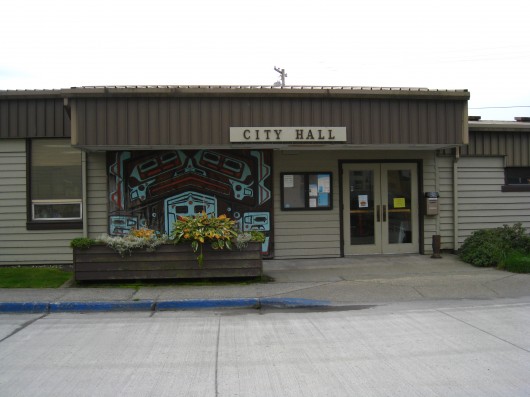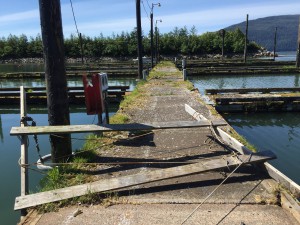Like other municipalities around the state, Wrangell is struggling to deal with expected decreases in state funding and increasing costs. The Wrangell borough is considering a balanced budget for the upcoming year, but has had to leave some positions unfilled and raise the cost of some services.
The Borough Assembly will hold a public hearing Tuesday evening at 5:45 pm and a budget workshop at 6 pm. The Assembly will hold one more public hearing before their June 14 regular meeting where the final budget will be passed.
The borough’s current draft of the 2017 budget still has some key issues up in the air to hash out as the state Legislature’s final budget remains to be seen. However, the borough is anticipating some cuts to state funding, among them is a 37 percent cut to municipal revenue sharing and a 45 percent cut to funding for the jail. Borough manager Jeff Jabusch explains the proposed budget does not rely on tax increases.
“We hope to provide the same level of services for our citizens. We’re not proposing any mill rate increase for property taxes. Sales tax will remain the same. I think those are important elements of the budget considering the huge hits we’ve had from the state sources lately,” he said.
The current property tax rate is 12.75 mills, and sales tax in Wrangell is at seven percent. The borough’s Finance Director, Lee Burgess says even with state funding down and costs up, the city managed to propose a balanced budget, but that has meant some budget cutting.
“We’ve through attrition eliminated a couple of positions over the past couple of years,” he said.
Some of those positions not being filled include the museum director, a police officer and a part-time collection clerk. Another pinch on the budget has been an increase in some costs for the borough.
The borough is also facing a $361,000 spike in health insurance premiums in the coming fiscal year. Burgess says the borough is looking into alternatives, but deductibles are either higher, or the benefit packages aren’t as “attractive.”
“We’ve even contemplated at one point not even offering insurance plans at all and increasing wages so people can go purchase whatever insurances is best for them. There’s no real sweat deal to be had in insurance, at least in Alaska it seems,” said Burgess.
He said one of the factors for the spike is due to unexpected large claims in the 2016 fiscal year. The borough called in an insurance consultant this week to help answer some questions borough employees may have about the proposed options, but the current health plan may be the best choice.
“That’s probably the number one option is to stick with what we have, even though the rates are increasing as much as they are. Nothing is final at this point,” said Burgess.
Among other issues in the coming fiscal year are capital project requests that cannot be covered. Burgess says there were 3.2 million dollars in requests, but not all could be funded without running a deficit. One request going unfunded is a new fire truck.
“That’s been recommended, but at this point, it’s such a high dollar item and with everything going on, that wasn’t recommended,” said Burgess.
Wrangell’s oldest fire truck is over 30 years old. Jabusch says the borough is looking for federal grants to fund some capital projects that weren’t funded in the budget. While taxes are not expected to increase, Wrangell has had to look at increasing the cost of some services.
Also included in the budget is a 10 percent hike on fees for cruise ship and port facilities, the marine service center, and a restructuring of the harbor rates for boats. Harbor Master, Greg Meissner said the Port Commission proposed rate increases because they weren’t putting away enough money to fund future projects.
“You look at the cost of infrastructure, look at simply the finger costs for an 80-foot boat vs a 20-foot boat. The square-footage costs for that stall and all that comes with it were way more per square foot than a 20-foot stall. We realized the little boats were closer to paying their fair share if you will. The big boats weren’t even paying for replacement costs of the finger,” said Meissner.
A tiered system for harbor rates would replace the current flat rate of $25 per foot and
would have longer boats paying more .
Boat lengths would be put into three categories: 0 feet to 30 feet which would cost $28 per foot, 31feet to 56 feet, which Meissner said the majority of ships in the harbor fall under, would bump up to $33 per foot, and boats 56 feet and up will pay $38 per foot if the proposed rates pass with the budget.
Meissner says the Port Commission has not raised rates for about eight years. He hopes these fees would cover 50 percent of much needed future projects like the Shoemaker Bay Harbor overhaul. That project has an estimated cost of 11 million dollars. The current float system at Shoemaker is in poor condition and the north end of the dock is unable to be used.
“It probably had a design life of 25 years in reality, maybe 30. It’s 38 years old now, going on 39. The woods rotting, the concrete is spalling, and the thing is slowly slowly sinking,” said Meissner.
Meissner hopes the other half of the project and others like it will be covered by a state harbor matching grant.













